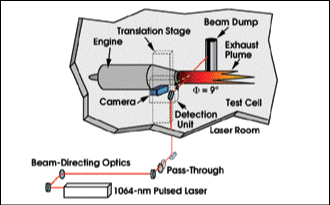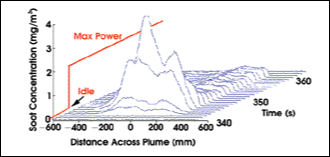
Laser-Induced Incandescence Measures Soot in Jet Exhaust
Brent D. Johnson
When monitoring the performance of jet engines, aerospace engineers typically are concerned with intake phenomena, such as how wind velocity, rain and shock waves affect the turbine at subsonic to supersonic speeds. But a growing awareness of the adverse health effects of air pollutants has led to a renewed interest in understanding what happens at the other end of the system, when an exhaust plume leaves the engine. Peter DeBarber and Tom Jenkins of MetroLaser Inc. in Irvine, Calif., have devised a nonextractive measurement technique that uses laser-induced incandescence to obtain real-time images of soot concentrations in engine exhausts and other flow fields.
Particulate matter emission in the form of soot is one of the most significant pollutants from commercial jet engines. It originates from the incomplete combustion of fuel and is particularly problematic during takeoff, which requires high fuel consumption. Researchers have measured these emissions using an extraction technique in which they sample the exhausts through a filter paper and analyze the soot they capture under a microscope. However, this approach is unreliable for particles smaller than 20 nm, which can slip through the filter. Moreover, the results are not available immediately, and the method does not yield imaging information.
DeBarber explained that the laser-induced incandescence technique has existed in some form since the late 1970s, when it was discovered as interference in measurements taken of rocket exhaust. Only recently have the experimental and theoretical efforts converged to overcome calibration concerns and enable its practical, quantitative use.

Figure 1. Researchers have developed a laser-induced incandescence system to measure the concentration of soot in jet exhaust. The laser is located outside the test chamber, and the user remotely operates the system by computer.
In the setup, a 1064-nm beam from a Continuum Surelite Nd:YAG laser is launched across the exhaust plume of an engine under test (Figure 1). Soot particles in the exhaust absorb part of the 600-mJ pulses, heat to 4000 K and emit incandescent light. The exhaust temperature depends on the throttle conditions and the exhaust profile, varying from just above 300 K to approximately 1000 K, but this background temperature is sufficiently lower than the incandescence temperature.
To collect the signal from the heated particulates, the researchers employ a DH520-185-11 intensified CCD camera from Andor Technology of Northern Ireland. It features a
controllable intensifier gating to offer a 1000 times increase in gain. Both the laser and the camera timing are controlled with digital pulse generators that enable a precise delay to be applied to the camera gate pulse with respect to the laser. The camera gate is synchronized with a 20-Hz laser to improve the signal-to-noise ratio, typically opening approximately 10 ns after an 8-ns laser pulse and remaining open for 50 ns.
In ground tests conducted at the Arnold Engineering Development Center at Arnold Air Force Base in Tennessee, the instrument imaged a 1-m chord of an exhaust plume with a spatial resolution of 5 cm in 0.1 s. Data from these tests indicate that the soot concentration jumped to 4 mg/m3 immediately after the throttle was increased to full power and remained high for several seconds before dropping back to a steady state of 0.3 mg/m3 (Figure 2).

Figure 2. Data taken on a jet engine in operation show a transient spike in the soot mass concentration as the throttle setting jumps to maximum power.
The test results demonstrate that laser-induced incandescence is an accurate and rapid approach to generating needed data on soot mass. Ultimately, the findings may be used to improve engine performance and to reduce emissions.
Published: September 2003